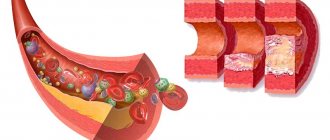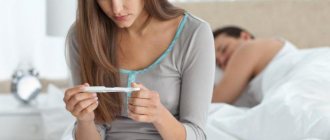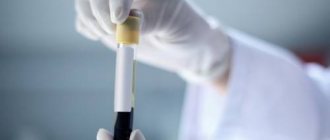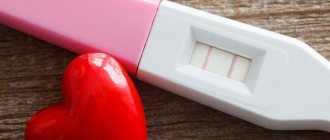The ratio of the hormones FSH and LH affects the reproductive function of a woman. These are hormones that determine endocrine function and the ability to conceive. The likelihood of getting pregnant decreases if the ratio of LH and FSH is disturbed. If a woman is suspected of infertility or is not pregnant for a long time, the doctor prescribes a test to determine LH and FSH. He will tell you when is the best time to take the test and how to prepare for it.
However, laboratory technicians give some advice on how to take the test correctly:
- they come to the laboratory in the morning immediately after waking up;
- you should not eat food before the study;
- You cannot drink alcohol or consume nicotine for 1 day;
- It is prohibited to use new medicinal substances without a doctor’s permission, especially those of a hormonal nature.
Before signing up for testing, be sure to check with your therapist on which day of your cycle to donate blood.
What are FSH and LH?
The main function of follicle-stimulating hormone (FSH, follitropin) in the female body is the production of estrogens and acceleration of follicle maturation. Estrogens, as the main female sex hormones, maintain the normal state of eggs and the entire process of fertilization and gestation.
LH (luteinizing hormone, lutropin) also regulates important processes in the reproductive system. Its concentration increases sharply during the period of egg ovulation. At such a moment, FSH levels decrease, as for estradiol and progesterone, their quantity, on the contrary, increases. This process is favorable for conception. If fertilization does not occur, the concentration of LH decreases, and FSH should increase. The whole process completely depends on the characteristics of the woman’s cycle.
The described hormones, including prolactin, are produced by pituitary cells, which in medicine are commonly called gonadotrophs. FSH, LH have an effect on the ovaries, their indicators are determined in case of infertility and other pathologies.
Increased FSH in the follicular phase of the cycle
Simultaneously with the onset of menstrual bleeding, FSH production begins to increase. The activity of the pituitary gland is associated with a sharply decreased level of progesterone. Receptors report the completion of the previous cycle, after which a new one starts. FSH is produced unevenly, but spasmodically, in periods of 15 minutes. every 1.5 – 4 hours. Because of this, hormone levels may fluctuate throughout the day.
The production of FSH is influenced by factors such as nervous tension, since the cortisol produced during this process, the stress hormone, reduces the amount of sex hormone released into the blood. FSH plays the most important role in the follicular phase of the cycle - it triggers the development of follicles in the ovaries. Its concentration in the blood varies depending on the day of the cycle.
Table 1. FSH in the blood of women is normal
| Cycle phase | Period | Contents of FSH |
| Follicular | from the 1st day of menstruation until the end of bleeding | 6 – 14 mIU/ml |
| from 5 – 6 days before ovulation | 3.5 – 12.5 mIU/ml | |
| Ovulatory | from 13 to 16 days (ovulation) | 7 – 26 mIU/ml |
| Luteal | from 16 to 28 days | 3.5 – 15 mIU/ml |
FSH plays its main role in the follicular phase of the cycle. Under its influence, differentiation of follicle shell cells begins, which will degenerate into glandular tissue and begin to produce progesterone. It is the release of FSH at the end of the first phase that leads to rupture of the follicle and release of the egg. This hormone increases the amount of testosterone in the blood, which stimulates sexual desire on those days of the cycle when conception is most likely.
An increase in the level of this hormone indicates various disorders, but they are all associated with the functioning of the gonads. On the contrary, pathology of the pituitary gland or hypothalamus is indicated by its insufficient quantity.
So, an increase in FSH is due to the response of the ovaries, this may indicate the following problems:
- Tumors or cysts on the ovaries;
- Ovarian exhaustion;
- Insufficient amount of steroid hormones - androgens;
- Endometriosis;
- Menopause;
- Tumors in other organs that can stimulate FSH production
The content of this hormone is also influenced by external factors that are not systemic in nature and can be eliminated:
- Radioactive exposure – X-ray or MRI;
- Smoking and alcohol abuse;
- Taking hormonal contraceptives;
- Taking other hormonal drugs.
With increased FSH, the production of progesterone and estrogen is disrupted, and sometimes underdevelopment of the follicle is possible.
An excess of this hormone is detected in the following diseases:
- Irregular cycle;
- Periodic absence of ovulation;
- Endometriosis and uterine bleeding;
- Ovarian dysfunction;
- Infertility and miscarriage.
Ratio of LH and FSH
When planning pregnancy, the permissible ratio of these hormones relative to each other must be observed. Otherwise, there is no ovulation and conception does not occur. The indicator of each of them is important individually, so the gynecologist prescribes general tests to determine the concentration of the described hormones, as well as SHBG (a protein that can bind sex hormones).
Normal values of FSH, LH
The normal levels of follicle-stimulating hormone are determined within the following limits:
- ovulation – 4.7–22 mU/ml,
- follicle growth – 3.5–13 mU/ml,
- luteal phase – 4–12 mU/ml.
To obtain reliable results, it is necessary to take tests at different periods of the menstrual cycle.
As for the concentration of FSH in men, it is represented by stable indicators ranging from 1.5–12 mU/ml.
Normal parameters of luteinizing hormone can be determined by the following numbers:
- ovulation – 24–150 mU/ml,
- follicle growth – 2–14 mU/ml,
- luteal norm is 2–17 mU/ml.
The ratio of hormones varies and largely depends on the age of the woman. Thus, in girls and boys who have not entered the phase of puberty, the hormonal norm is determined by the same LH/FSH content, the ratio formula is 1 to 1. After complete maturation of the reproductive organs, luteinizing hormone exceeds follicle-stimulating hormone by 1.5 times. The normal ratio of FSH and LH in the first phase of menstruation is determined by the predominance in the amount of follitropin, in the second - vice versa.
The concentration of hormones is represented by unstable values, which under the influence of certain factors can change significantly. Therefore, FSH and LH levels in the follicular and luteal phases will be different. Their determination is important during pregnancy planning, in preparation for the IVF procedure.
Menstrual cycle
Normally, the ratio of LH and FSH in an adult woman should be 1.5-2 to 1. In the body of girls who have not yet begun menstruation, the pituitary gland synthesizes these substances in equal quantities (1:1). With the development of the body and internal genital organs, the regulatory mechanism changes. At approximately 11-14 years of age, puberty begins and the formation of follicles in the ovaries depends on the day of the menstrual cycle, which normally lasts 28 days. Fluctuations of up to several days are considered physiological, however, it is necessary to ensure that there are no too strong delays. This may indicate the presence of organic and functional diseases of the woman’s body.
The cycle itself is divided into 2 phases:
- follicular (1-14 days),
- luteal (15-28 days).
The name makes it clear which hormone increases in the blood when it increases. The most suitable day for conception and planning a subsequent pregnancy is the 14th-15th with the usual duration of menstruation.
Indications for analysis
An assessment of the FSH/LH ratio in men and women is carried out during examination for infertility, as well as to monitor the treatment of reproductive pathologies. This analysis is also indicated before the IVF procedure. During the study, it is necessary to donate blood to establish each of the indicators separately in order to calculate the LH/FSH balance using the formula. It is important to establish a specific day of the menstrual phase on which the tests will take place, and to follow some rules, in particular:
- quit smoking immediately before donating blood,
- eating at least 8–10 hours before the test,
- absence of excessive physical exertion, emotional stress,
- refusal of alcoholic beverages the day before the test.
FSH and LH are taken on what day of the cycle? Usually this procedure is carried out from 3 to 8 days, and can be performed several times. At the indicated time, the ratio of follitropin to lutropin is 1.5 to 2. Expanded ranges of such indicators are also possible, it all depends on the individual characteristics of the body.
High LH
My husband and I have been planning for a baby since April 2014. My husband passed all the necessary tests, MAP test, ultrasound - complete normal.
My problem turned out to be high LH in the first phase. In this case, there is no talk of polycystic disease. They have never installed it and they don’t install it now. Because my ovaries are in perfect order and do not correspond to the diagnosis of PCOS.
In general, regarding high LH. The doctor prescribed Diane-35 for 3 months. Then get tested immediately. And immediately run to her. He says that a couple of cycles after stopping Diane-35 will be very successful.
My question is for those girls who have had similar problems. And how did the situation develop further? Has taking OK helped anyone overcome high LH? Did anyone get pregnant later?
Please, if anyone has stories on this topic, tell them.
Thank you for your attention.
Ok don't fight lg, your doctor is a fool
What fights lie?
Well, how do you increase FSH?
That is, just do stimulation?
The cause of hibernation is increased testosterone and prolactin. As I understand it, it's all interconnected.
Well, if you fight with Prolactin and testosterone, it will suddenly become better. I was on stimulation
Alena, I have elevated LH, but I have polycystic disease. The first thing I'll ask you is, are you ovulating? If so, then does it make sense to lower the blood pressure and drink for Diana? So I’ll describe my situation, there was no ovulation, elevated LH, I was also prescribed Diana 35 for 3 months, after the cancellation I actually ovulated only once. and then everything returned to its place. You need to be in time for this 1-2 cycles, as the doctor says. and still ask about polycystic disease, everything points to it, you don’t have to draw conclusions just from the ultrasound. At least the doctor is trying to “treat” you exactly the same way they “treat” polycystic disease. Unless, of course, it can be called treatment.
Nadezhda, thank you for your detailed answer. I have been diagnosed with high PH for a long time. But since I wasn’t planning a pregnancy then, I was prescribed Novinet and told to go for an ultrasound every six months. did everything. I've been drinking for almost 3 years. Then she got married and began planning a pregnancy. Canceled OK. And everything was quite smooth. But then the cycle began to lengthen. I was sent for tests. It turned out that LH was high. The cycle does not always involve ovulation. Every other time, I would say. When high PH was first diagnosed, it was much higher than normal. This time it was just a little high, but not too high. Therefore, the doctor said that, judging by the trend, he will still grow. I asked the question about PCOS directly. To which she replied that other hormones and the ultrasound picture refute PCOS. Well, I read my own ultrasound myself. And I surfed the Internet. Doesn't look like polycystic disease. Although, of course, the doctor said that with such PH, it could develop in me if measures are not taken now to reduce PH.
As a result, she offered me either stimulation now. Or try this way to reduce LH. And then try to get pregnant quickly. And, if then it doesn’t work out, then there’s stimulation. I think that she hopes for the same picture as she had after taking previous OCs. Because when I quit them, I had about 2-3 cycles that were just great. There was ovulation, the cycle lasted 28 days. But then the endometrium pumped up. I believe that now she thinks that she will lower LH, there will be ovulation, and the endometrium will grow.
Reasons for deviation from the norm
If the study of biomaterial reveals elevated levels of follitropin and luteinizing hormone, this may indicate dangerous pathologies occurring in the body. There are a number of reasons that lead to such a deviation from normal indicators:
- ovarian failure,
- androgen imbalance,
- cysts.
But during menopause, high levels of the hormones FSH and LH are acceptable in most cases.
If a serious excess of follitropin is detected, there is a high risk of developing uterine bleeding independent of menstrual bleeding. In some women, on the contrary, menstrual flow completely disappears, which entails the onset of early menopause. To avoid disorders of the reproductive system, the concentration of hormones should be normalized as soon as possible. Consultation with a gynecologist or endocrinologist is necessary. Low levels of LH and FSH are dangerous to health. If you do not seek qualified help in a timely manner, irreversible consequences may occur:
- anovulation,
- disturbance in the development of the mammary gland,
- lack of libido,
- scanty discharge during menstruation,
- abnormal development of internal reproductive organs,
- improper formation of the external genitalia.
It is important to identify the described changes in the body as early as possible, preferably during adolescence. Otherwise, it will be possible to lower or increase the value of hormones, but the consequences of such transformations may be disappointing.
What affects hormone levels?
Low concentrations can be caused by dysfunction of the anterior pituitary gland. The cause is also a malfunction of the hypothalamus, excess weight, because. adipose tissue is capable of producing sex hormones. In addition, obesity can develop against the background of disturbances in the concentration of pituitary hormones.
Elevated levels of FSH and LH can be caused by a neoplasm in the pituitary gland, which can only be detected by tomography.
If measures are not taken to regulate hormone levels, this causes disruption of neuroendocrine mechanisms. Indicators above the norm are revealed as a result of excessive sports activities, strict diets, and emotional disorders.
If the decoding of the chromosome analysis showed the partial/complete absence of some chromosomes in a woman or the presence of an additional X chromosome in a man, a malfunction in the FSH/LH ratio will most likely be detected.











